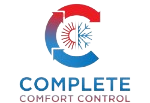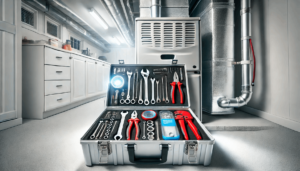Introduction
Preventative maintenance for heating, ventilation, and air conditioning (HVAC) systems is essential to ensure they function efficiently and reliably year-round. These systems work continuously to regulate indoor temperatures, making them prone to wear and tear over time. Without regular maintenance, they can become less efficient, leading to higher energy consumption, more frequent breakdowns, and costly repairs.
Regular maintenance helps catch small issues before they turn into major problems, reducing the risk of system failure during extreme weather conditions. This not only prolongs the life of the system but also improves energy efficiency, which can significantly lower utility bills. Additionally, well-maintained systems perform better, providing consistent comfort and cleaner air quality inside homes or buildings.
Check and Replace Air Filters Regularly
Importance of Clean Filters for System Efficiency and Air Quality
Air filters play a crucial role in maintaining your HVAC system’s efficiency and the quality of the air inside your home. These filters trap dust, dirt, allergens, and other airborne particles, preventing them from circulating through the system and into your living space. Clean filters ensure proper airflow, helping the system run efficiently and improving the air you breathe.
Frequency of Filter Changes
The frequency of changing air filters depends on various factors such as the type of filter, the environment, and how often the system is used. In general, filters should be checked every month and replaced every 1 to 3 months. Homes with pets, people with allergies, or those in dusty environments may need to change filters more frequently.
How Dirty Filters Cause Strain on the System
When filters become clogged with dust and debris, it reduces airflow through the system. This forces the HVAC system to work harder to maintain the desired temperature, increasing energy consumption and causing unnecessary strain on components like the fan motor. Over time, this added stress can lead to premature wear and system breakdowns, resulting in higher maintenance costs and reduced system lifespan. Keeping filters clean is one of the simplest and most effective ways to prevent these issues.
Clean the Coils
Explanation of Evaporator and Condenser Coils
HVAC systems have two types of coils: evaporator coils and condenser coils. The evaporator coil is located indoors and absorbs heat from the air inside your home, helping cool it down. The condenser coil, located in the outdoor unit, releases the heat absorbed by the evaporator coil to the outside air. Together, these coils are essential for the system’s cooling and heating efficiency.
How Dirt Buildup Reduces Heat Absorption and Cooling Efficiency
Over time, dirt, dust, and debris accumulate on both the evaporator and condenser coils. When this happens, it reduces the coils’ ability to transfer heat efficiently. The evaporator coil becomes less effective at absorbing heat, and the condenser coil struggles to release it, forcing the system to work harder. This leads to a significant drop in cooling performance, higher energy consumption, and potential system overheating or failure.
Tips on Safely Cleaning Coils or When to Hire a Professional
- Evaporator Coils: These are often located in difficult-to-reach areas, so gently brushing away dirt or using compressed air is recommended. However, it’s easy to damage the coils if not handled properly, so consulting the manufacturer’s manual or hiring a professional is often safer.
- Condenser Coils: Since the outdoor unit is exposed to the elements, it’s more prone to collecting debris like leaves and grass clippings. You can safely clean these coils by turning off the power and using a garden hose with a gentle stream to wash away the dirt. Be sure to avoid bending the fins.
- When to Hire a Professional: If the coils are heavily soiled, or if you are unsure of how to clean them properly, it’s best to call a professional technician. They have specialized tools and the expertise to thoroughly clean and inspect the coils without causing damage, ensuring your system operates at peak efficiency
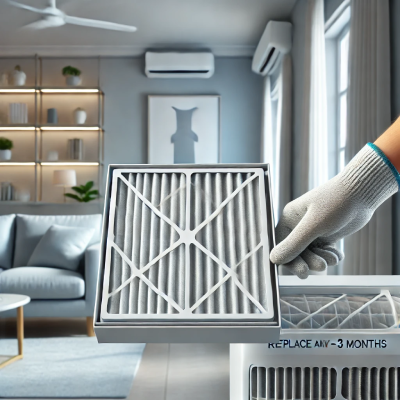
Inspect and Clear Ductwork
Importance of Clean and Sealed Ductwork for Optimal Air Flow
Ductwork is the system of passages that distributes heated or cooled air throughout your home. For your HVAC system to work efficiently, the ductwork must be clean and well-sealed. Dirty or leaky ducts can reduce airflow, making it harder for the system to maintain a consistent temperature. This forces the HVAC system to work harder, leading to increased energy consumption and higher utility bills. Sealed ducts prevent air leakage, ensuring the air your system heats or cools reaches its destination efficiently.
Signs of Leaky Ducts, Blocked Vents, or Dirt Buildup
- Leaky Ducts: Common signs include uneven room temperatures, higher-than-usual energy bills, or visibly loose connections between duct sections. Leaks allow conditioned air to escape, reducing the overall effectiveness of the system.
- Blocked Vents: Rooms may feel stuffy or have reduced airflow. Blocked vents can occur due to dirt buildup, debris, or objects like furniture obstructing the air passages.
- Dirt Buildup: If you notice excessive dust around your vents or inside your home, or if your HVAC filters get dirty quickly, it could be a sign that the ducts need cleaning. Dust and debris inside the ducts can circulate in the air, reducing indoor air quality.
How Duct Maintenance Can Improve System Efficiency and Indoor Air Quality
Regular duct maintenance ensures that air flows freely and efficiently throughout your home. Clean, sealed ducts allow the HVAC system to work at its optimal performance, reducing strain on the system and helping it use less energy. This can lead to lower energy bills and a longer lifespan for the HVAC system.
Additionally, clean ducts reduce the amount of dust, allergens, and contaminants circulating in your home’s air, improving overall indoor air quality. This is especially important for households with people who have allergies or respiratory conditions. Periodic inspection and cleaning of ductwork can keep your system running smoothly and maintain a healthier indoor environment.
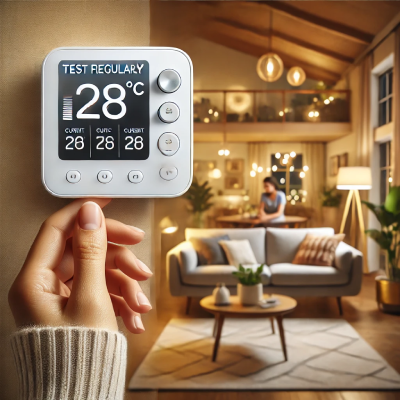
Test Thermostat Functionality
Ensuring Proper Thermostat Calibration for Accurate Temperature Control
A thermostat acts as the control center for your HVAC system, regulating the temperature in your home. If it’s not properly calibrated, the system may heat or cool your space inefficiently, leading to discomfort and energy waste. Regularly testing your thermostat ensures that it’s accurately measuring and controlling the temperature, allowing your HVAC system to operate at peak performance. Miscalibrated thermostats can cause the system to run longer than necessary or shut off prematurely, leading to uneven temperatures and higher utility bills.
Benefits of Programmable or Smart Thermostats for Energy Savings
Upgrading to a programmable or smart thermostat can greatly enhance both comfort and energy efficiency. These thermostats allow you to set temperature schedules based on your daily routine, reducing energy consumption when you’re not home or when you’re asleep. Smart thermostats can even learn your habits and automatically adjust temperatures for maximum efficiency. They offer remote control via smartphone apps, allowing you to manage the system from anywhere, leading to even greater energy savings. This can result in lower utility bills and a more sustainable way of using your HVAC system.
Simple Tips to Troubleshoot Thermostat Issues
- Check the Settings: Ensure the thermostat is set to the correct mode (heating or cooling) and the desired temperature is appropriately set. Sometimes a simple mistake in settings can cause issues.
- Inspect Power Supply: If the thermostat display is blank or the system isn’t responding, check the power source. Replace batteries if needed, or make sure the device is properly connected to the electrical system.
- Location Matters: If your thermostat is located near heat sources, direct sunlight, or drafty areas, it may give inaccurate temperature readings. Relocating the thermostat to a central, unaffected location can help improve accuracy.
- Check the Thermostat’s Age: Older thermostats may become less reliable over time. If your thermostat is outdated, it might be time to consider replacing it with a newer, more efficient model.
- Reset the Thermostat: Sometimes, a simple reset can resolve minor glitches. Refer to the manufacturer’s manual for instructions on how to perform a reset. If issues persist, consult a professional to inspect the thermostat and system wiring.
Lubricate Moving Parts
Importance of Keeping Fans, Belts, and Other Mechanical Parts Lubricated to Reduce Friction and Wear
HVAC systems consist of various moving parts, such as fans, motors, and belts, that need to operate smoothly for optimal performance. These components experience constant movement, which generates friction. Over time, without proper lubrication, this friction can lead to wear and tear, causing parts to degrade more quickly. By regularly lubricating these moving parts, you can significantly reduce friction, ensuring they operate efficiently and minimizing unnecessary stress on the system.
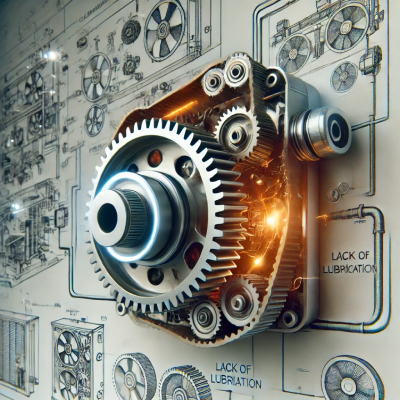
How This Step Prevents Overheating and Prolongs Component Life
Without sufficient lubrication, moving parts can become stiff, which forces the HVAC system to work harder. This added strain can lead to overheating, especially in components like fan motors and belts. Overheating not only reduces the efficiency of the system but can also cause parts to break down prematurely, leading to costly repairs or replacements.
Regular lubrication helps prevent this by keeping parts running smoothly, reducing heat buildup, and maintaining a more consistent and efficient operation. By prolonging the life of critical components like fans and motors, you not only prevent overheating but also extend the overall lifespan of the HVAC system, saving on repair and replacement costs in the long term.
Inspect Refrigerant Levels
Why Proper Refrigerant Levels Are Crucial for System Efficiency
Refrigerant is a vital component of an HVAC system, responsible for absorbing and releasing heat to cool or heat your home. If the refrigerant level is too low, the system cannot effectively transfer heat, resulting in reduced cooling or heating efficiency. Proper refrigerant levels ensure the system operates smoothly and maintains the desired indoor temperature without excessive energy use. Insufficient refrigerant can force the system to work harder, increasing energy consumption and shortening the life of key components like the compressor.
Signs of Refrigerant Leaks and How They Impact Performance
- Weak Cooling or Heating: If the system is running but not effectively cooling or heating your space, it may be a sign of low refrigerant levels caused by a leak.
- Longer Operating Cycles: The system may run for extended periods without achieving the desired temperature, leading to higher energy bills.
- Hissing or Bubbling Noises: These sounds can indicate a refrigerant leak, as they may be caused by escaping gas from a hole or crack in the refrigerant lines.
- Frozen Evaporator Coils: Low refrigerant can cause the evaporator coils to freeze, preventing the system from cooling properly.
Refrigerant leaks not only reduce performance but can also cause damage to the compressor, one of the most expensive components to replace. Running an HVAC system with low refrigerant can lead to system failure and costly repairs.
When to Call a Professional to Check and Refill Refrigerant
Since refrigerant is a hazardous substance and must be handled carefully, it’s important to call a licensed HVAC professional to inspect refrigerant levels, diagnose leaks, and refill the refrigerant if needed. If you notice signs of a leak or a drop in performance, a professional can safely test the system, repair leaks, and recharge the refrigerant to the proper level. Regular inspections by a professional can prevent serious issues and ensure your system maintains optimal efficiency.
Check Electrical Connections and Controls
Importance of Inspecting Electrical Connections to Prevent Shorts and System Failures
Electrical connections are the lifeline of your HVAC system, providing the power it needs to run efficiently. Over time, these connections can loosen, corrode, or degrade due to wear, heat, or vibration. If not inspected regularly, poor electrical connections can lead to shorts, which may cause the system to malfunction, shut down, or operate inefficiently. Regularly inspecting and tightening electrical connections helps ensure reliable performance and prevents costly breakdowns.
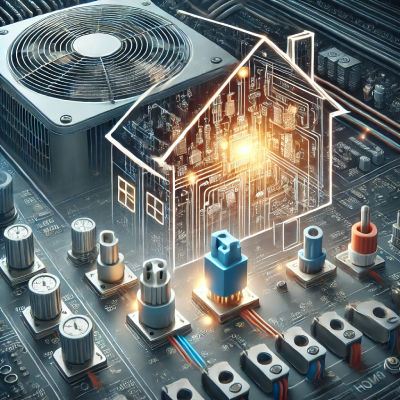
How Faulty Wiring Can Increase the Risk of Fire or System Damage
Faulty wiring is a serious hazard for any HVAC system. Loose, frayed, or damaged wires can lead to electrical arcing, which not only disrupts system operation but can also ignite surrounding materials, increasing the risk of a fire. Additionally, improper voltage or wiring can cause system components, such as motors or capacitors, to overheat or fail prematurely. This not only threatens the safety of your home but can lead to expensive repairs or complete system failure.
The Role of Professional Inspections for Electrical Components
While basic visual checks of wiring and connections can be done by homeowners, a thorough inspection should always be carried out by a licensed HVAC technician. Professionals have the tools and expertise to safely test electrical components, including capacitors, contactors, and circuit boards. They can detect hidden problems, like improper voltage or imbalanced electrical loads, and make necessary repairs to prevent future issues. Scheduling regular professional electrical inspections helps prevent dangerous situations and ensures your system operates safely and efficiently.
By keeping your HVAC system’s electrical connections in check, you protect both the equipment and your home from potential hazards.
Keep Outdoor Units Free from Obstructions
Ensuring the Outdoor Condenser Unit Is Clear of Debris Like Leaves, Branches, and Dirt
The outdoor condenser unit of your HVAC system plays a crucial role in releasing heat absorbed from your home. However, since it’s exposed to the elements, it is prone to collecting debris like leaves, branches, grass clippings, and dirt. If these materials accumulate around or on the condenser, they can block airflow, reduce the unit’s efficiency, and lead to system strain. Keeping the area surrounding the unit clear of debris ensures it operates efficiently and prevents overheating or damage.
Importance of Sufficient Airflow for the Unit’s Efficiency
For the outdoor condenser unit to function properly, it needs ample airflow to efficiently release heat into the outside air. Restricted airflow caused by obstructions can lead to reduced cooling efficiency, increased energy consumption, and overheating of the system. Without proper ventilation, the condenser has to work harder, which can shorten its lifespan and lead to costly repairs or reduced overall system performance. Ensuring the unit has adequate clearance on all sides (at least 2-3 feet) is key to maintaining its efficiency.
Simple Tips for Safely Cleaning and Maintaining the Exterior Unit
- Turn Off the Power: Before performing any maintenance on the condenser, ensure the power to the unit is turned off to avoid any electrical hazards.
- Remove Debris: Use a soft brush or gloves to clear away any debris from the unit and the surrounding area. Trim back any plants, shrubs, or branches to maintain a safe distance from the unit.
- Clean the Fins: The condenser unit has thin metal fins that can become clogged with dirt and dust. Use a garden hose to gently rinse the fins, spraying from the inside out to avoid bending them. Be careful not to use high pressure, which could damage the fins.
- Straighten Bent Fins: If the fins are bent, you can carefully straighten them using a fin comb or a butter knife, but be gentle to avoid breaking them.
- Inspect for Damage: While cleaning, check for signs of wear or damage such as rust, loose parts, or cracked insulation. If you notice anything unusual, it’s best to call a professional for further inspection.
By regularly maintaining the outdoor unit, you help ensure the entire HVAC system runs efficiently, reducing energy usage and extending the life of your equipment.
Schedule Professional HVAC Inspections
Why Regular Professional Maintenance Checks Are Crucial for Detecting Early Issues
Regular professional maintenance checks are essential for the longevity and efficiency of your HVAC system. During these inspections, trained technicians can identify and address minor issues before they escalate into major problems, which can lead to costly repairs and system failures. Early detection of potential issues, such as refrigerant leaks, electrical faults, or mechanical wear, ensures that your system runs smoothly and helps maintain optimal performance throughout the heating and cooling seasons.
What a Professional Technician Inspects
During a professional HVAC inspection, technicians perform a comprehensive evaluation of the system, which typically includes:
- System Performance: Technicians assess the overall performance of the HVAC system, including airflow, temperature differentials, and operational noise levels.
- Refrigerant Levels: They check refrigerant levels to ensure they are within the manufacturer’s specifications, identifying any leaks that may need repair.
- Electrical Components: Technicians inspect all electrical connections, wiring, and components for signs of wear, corrosion, or damage, ensuring safety and reliability.
- Mechanical Parts: They examine and lubricate moving parts like fans and motors, ensuring they operate smoothly and efficiently.
- Ductwork: An inspection of the ductwork for leaks, blockages, or signs of contamination to improve airflow and indoor air quality.
- Filters and Coils: Technicians may check and clean air filters and coils to optimize system efficiency.
Recommended Frequency of Inspections (Annually or Biannually)
To maintain peak performance, it is generally recommended to schedule professional HVAC inspections at least annually for most systems. However, for systems that are used heavily, or in areas with extreme weather conditions, biannual inspections (once in the spring and once in the fall) are advisable. Regular professional maintenance not only enhances efficiency but also helps extend the lifespan of the HVAC system, ultimately saving homeowners money in the long run.
Conclusion
Regular preventative maintenance is essential for the optimal performance and longevity of HVAC systems. By implementing simple yet effective tips—such as checking and replacing air filters, cleaning coils, inspecting ductwork, testing thermostat functionality, lubricating moving parts, checking refrigerant levels, ensuring electrical connections are secure, keeping outdoor units free from obstructions, and scheduling professional inspections—homeowners can significantly enhance the efficiency and reliability of their heating and cooling systems.
Following these maintenance practices not only promotes efficient operation but also helps lower overall energy costs and reduces the likelihood of unexpected breakdowns. A well-maintained HVAC system operates more effectively, ensuring a comfortable indoor environment while minimizing the financial burden of high utility bills and costly repairs.
Homeowners are encouraged to set reminders for regular maintenance tasks and to schedule professional inspections at least annually, or biannually if needed. By being proactive in HVAC care, you can avoid costly repairs and enjoy a more comfortable and energy-efficient home. Remember, a little attention today can lead to significant savings tomorrow!
Resources
Energy Star – HVAC Maintenance Checklist
- Offers a detailed checklist for HVAC maintenance, focusing on efficiency and system longevity.
American Society of Heating, Refrigerating and Air-Conditioning Engineers (ASHRAE) – ASHRAE.org
- ASHRAE is a leading authority on HVAC standards and best practices, providing resources on maintenance and energy efficiency.
Environmental Protection Agency (EPA) – EPA Indoor Air Quality
- Discusses the impact of HVAC maintenance on indoor air quality, including filter replacement and air duct care.
HVAC –https://www.hvac.com/– HVAC Maintenance Tips
- A practical resource on basic maintenance tips for homeowners, including filter changes and thermostat troubleshooting.
Carrier – HVAC Preventive Maintenance Tips
- Carrier, a leading HVAC manufacturer, offers professional advice on maintaining various HVAC components and when to seek professional help.
- A detailed guide to HVAC maintenance from another major manufacturer, covering all essential components like coils, filters, and outdoor units.
